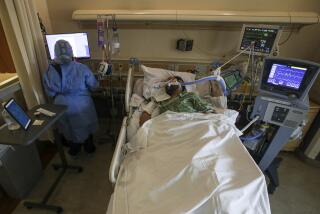H1N1 Affected 1 in 6 Americans
- Share via
About 50 million Americans had contracted pandemic H1N1 influenza through Nov. 14, according to the newest estimates from the Centers for Disease Control and Prevention released Thursday -- meaning that about 15% of the entire country has been infected, about 1 in every 6 people.
“That still leaves most people not having been infected and still susceptible,” CDC Director Dr. Thomas R. Frieden said at a news conference. The agency also reported that more than 200,000 people had been hospitalized and nearly 10,000 had died.
Estimates released about a month ago showed 22 million Americans had been infected and that 3,900 had died. But that does not mean that 6,000 people died in the intervening month, Frieden said; delays in reporting account for some of the increase.
Frieden said the 200,000 hospitalizations since the beginning of the pandemic seven months ago is about the same as in a usual flu season.
The deaths are lower than the 35,000 associated with seasonal flu in a typical year, but the breakdown is sharply different.
The 10,000 deaths include 1,100 children and 7,500 adults 18 to 64. Those figures “are much higher than in a usual flu season,” Frieden said.
In a normal flu season, there are about 1,000 deaths among Americans under 50. “But a large proportion of the 7,500 adults [who died] are under 50,” he said. Hospitalizations among the younger group are also several times higher than normal.
The estimates are compiled from the number of laboratory-confirmed cases and from cases that may be listed on death certificates as pneumonia, organ failure or other infections, but that were precipitated by flu.
Since the beginning of the pandemic, researchers have been concerned by anecdotal reports that indigenous peoples suffer more from H1N1.
In a new study, CDC researchers found that the death rate for this group is four times higher than normal. The study, published Thursday in the agency’s Morbidity and Mortality Weekly Report, used data from 12 states that accounted for about half of the Native American population.
“That is most likely a reflection of environmental factors, underlying health conditions and access to healthcare,” Frieden said.
In particular, diabetes is very prevalent among Native Americans. Such underlying conditions place people at higher risk of hospitalization and death from flu. Native Americans are among those with a high priority for the H1N1 flu vaccination, but the agency has no data on what proportion has received the shots, Frieden said.
H1N1 flu vaccine supplies continue to grow, he said. There are 85 million doses available, up by 12 million from last week. As supplies have increased, many communities have begun to expand eligibility for the vaccine to include the population at large.
Frieden recommended that people get the H1N1 flu vaccine because of uncertainties about whether a new wave of infections will hit in 2010. “What will happen in the future, only the future will tell,” he said.
More to Read
Sign up for Essential California
The most important California stories and recommendations in your inbox every morning.
You may occasionally receive promotional content from the Los Angeles Times.










